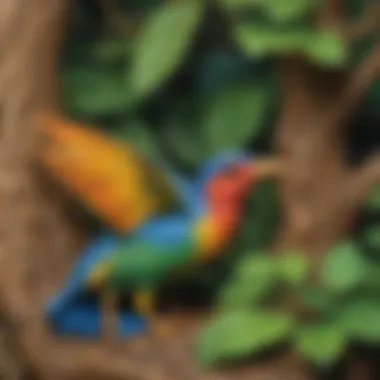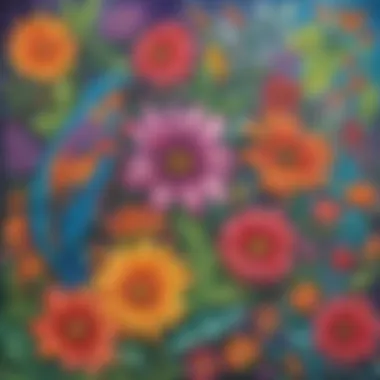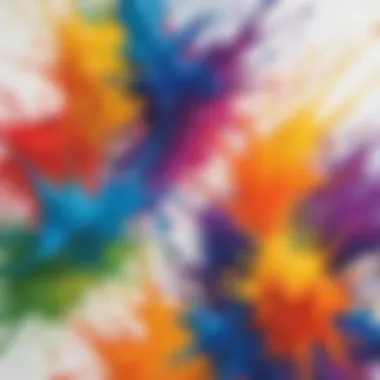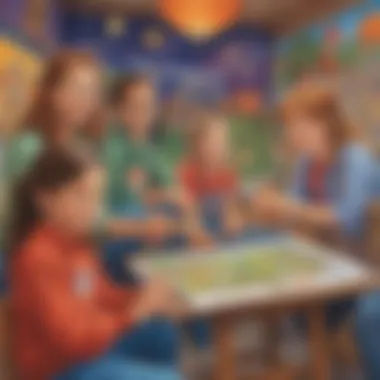Unlocking Creativity: Group Art Projects for Young Artists


Science Fun Facts
Art can also be a science! Did you know that mixing certain colors can create new colors? For example, blending red and yellow paint together can make orange. This is because each color reflects and absorbs different wavelengths of light, creating a unique hue when combined.
Artistic creations like murals involve more than just colors. They also require careful planning and measurement. Artists often use rulers and grids to ensure that the proportions and perspectives in their artwork are accurate. This mathematical aspect of art showcases how art and science can intertwine in fascinating ways.
With group art projects, students learn not only about artistic techniques but also about teamwork and problem-solving. By collaborating on a larger piece, they understand the importance of communication and coordination, much like scientists working together to achieve a common goal.
Discover the Wonders of Science
As young artists delve into group art projects, they encounter various scientific concepts without even realizing it. For instance, sculpting with clay involves understanding textures and shapes, which are fundamental concepts in materials science.
Educational videos and animations can further enhance the learning experience. Students can watch time-lapse videos of mural paintings coming to life or explore animations illustrating how different clays are formed geologically. These visual aids make complex scientific principles more accessible and engaging.
Interactive learning tools offer hands-on experiences that bridge art and science seamlessly. Virtual sculpture simulations allow students to mold clay digitally, providing a virtual space for experimenting with shapes and structures. This interactive approach encourages exploration and creativity while reinforcing scientific concepts.
Science Quiz Time
To reinforce the scientific knowledge gained through group art projects, interactive quizzes can be a fun and effective tool. Students can test their understanding of color theory by matching colors with their complementary counterparts or solve brain teasers related to the physics of light and color.
Multiple-choice questions encourage critical thinking and reasoning skills. Questions like 'Which primary colors can be combined to make secondary colors?' prompt students to recall and apply their knowledge, reinforcing the educational value of the art projects.
Learning through gamification adds an element of excitement to the learning process. By turning scientific concepts into puzzles or games, students stay engaged while deepening their understanding of the interconnectedness of art and science.
Science Experiment Showcase
Applying scientific principles to art projects can lead to fascinating experiments. For instance, exploring color mixing through chromatography can reveal the different pigments present in markers or paints. Through simple experiments like these, students can witness firsthand the science behind artistic creations.
Step-by-step instructions guide students through each experiment, emphasizing safety tips and precautions along the way. Wearing gloves when handling certain materials or working in a well-ventilated area are some of the precautions that ensure a safe and enriching learning environment.
Providing a materials list helps students gather the necessary supplies, promoting organization and preparedness. From paper chromatography strips to a variety of colored markers, having the right materials at hand enables students to conduct experiments with ease and focus on the scientific aspects of their art projects.
Introduction
In this article, we delve into the realm of group art projects tailored specifically for elementary students. These projects play a vital role in enriching the educational experience by nurturing creativity, collaboration, and skill development. By engaging in group art projects, students not only enhance their artistic abilities but also cultivate important social skills and individual growth. From mural painting to clay modeling, this guide serves as a comprehensive resource for educators and parents seeking to inspire and empower young artists.
Importance of Group Art Projects


Enhancing Creativity
The aspect of enhancing creativity holds paramount importance in group art projects for elementary students. By stimulating creativity, these projects serve as a catalyst for fostering imagination and originality amongst young minds. Encouraging children to think outside the box and explore unconventional ideas is a hallmark of enhancing creativity through art. This approach not only nurtures innovative thinking but also cultivates a sense of autonomy and self-expression in students, thus laying a strong foundation for their artistic journey.
Promoting Collaboration
Promoting collaboration is a cornerstone of group art projects for elementary students, emphasizing the value of teamwork and communication. Through collaborative art experiences, children learn crucial interpersonal skills such as sharing ideas, compromising, and working towards a common goal. Collaboration in art projects fosters a sense of community among students, enabling them to appreciate diverse perspectives and engage in constructive dialogue. This collaborative spirit not only enhances the quality of the artwork produced but also nurtures a sense of inclusivity and respect for others.
Developing Fine Motor Skills
The development of fine motor skills through group art projects is instrumental in enhancing students' tactile abilities and coordination. Engaging in activities that require intricate hand movements, such as painting, sculpting, and collage-making, helps children refine their dexterity and precision. Fine motor skill development in art not only benefits artistic endeavors but also contributes to overall physical and cognitive development in young learners. By honing their fine motor skills through creative expression, students improve their hand-eye coordination and spatial awareness, laying a solid foundation for future academic and artistic pursuits.
Benefits for Elementary Students
Social Development
Social development is a key benefit of engaging in group art projects for elementary students. Through collaborative art activities, children learn valuable social skills such as teamwork, communication, and conflict resolution. Art serves as a medium for students to interact with their peers, express emotions, and build relationships in a safe and creative environment. By engaging in group art projects, students develop empathy, cooperation, and a sense of belonging, fostering healthy social interactions both in and out of the classroom.
Confidence Building
The process of creating art in a group setting is instrumental in building confidence and self-esteem among elementary students. Art projects provide a platform for students to explore their creativity, take risks, and showcase their unique talents. Through positive reinforcement and recognition of their artistic accomplishments, children gain confidence in their abilities and artistic voice. The sense of achievement derived from completing group art projects instills a sense of pride and self-assurance in students, empowering them to embrace challenges and express themselves confidently in various aspects of their lives.
Cognitive Growth
Engaging in group art projects contributes significantly to the cognitive growth of elementary students. Art activities stimulate critical thinking, problem-solving, and visual-spatial skills, enhancing cognitive development in young learners. By exploring different art forms, techniques, and styles, students expand their creativity, imagination, and analytical abilities. The process of planning, designing, and executing group art projects fosters intellectual curiosity and cognitive flexibility, enabling students to approach challenges with innovation and resilience. As students navigate the complexities of art creation collaboratively, they enhance their cognitive capabilities and develop a deeper appreciation for the arts as a vehicle for intellectual growth and expression.
Types of Group Art Projects
Group art projects play a vital role in elementary education by fostering collaborative learning, creativity, and skill development. These projects offer students a holistic approach to art education, encouraging social interaction and individual growth. Among the different types of group art projects mentioned in this guide - mural painting, collage creations, clay modeling, and papier-mâché sculptures - there are various elements to consider. Each type not only enhances artistic skills but also promotes teamwork and critical thinking, making them essential in the curriculum.
Mural Painting
Community Themes
Mural painting with community themes is a unique way for students to engage with their surroundings. By depicting local stories, traditions, and values, students can connect with their environment while honing their artistic abilities. This aspect contributes significantly to the overall goal of fostering a sense of belonging and cultural appreciation. Community-themed murals provide a platform for students to showcase their creativity and celebrate the diversity within their community, making it a popular choice for group art projects.
Abstract Expressions
Incorporating abstract expressions in mural painting allows students to explore the realms of imagination and interpretation. This enables them to express emotions and ideas in a non-representational manner, encouraging creative thinking and originality. The key characteristic of abstract expressions is the freedom it offers for personal interpretation, inspiring students to think outside the box. While this approach may pose challenges in conveying specific narratives, it enhances students' artistic flexibility and individuality.


Historical Events
Exploring historical events through mural painting provides students with a unique perspective on storytelling and visual representation. By depicting significant historical moments or figures, students not only engage with the past but also learn to communicate complex ideas through art. The key characteristic of historical events in mural painting is its educational value, offering students a glimpse into the rich tapestry of history. While this theme requires research and attention to detail, it contributes to students' understanding of culture and heritage.
Collage Creations
Nature-inspired
Creating collages inspired by nature allows students to connect with the environment and express their appreciation for the natural world. This aspect contributes to the overall goal of instilling a sense of ecological awareness and responsibility in students. The key characteristic of nature-inspired collages is their ability to convey beauty and harmony through organic shapes and textures. While this theme promotes environmental consciousness, it may pose challenges in sourcing natural materials, requiring considerations for sustainability.
Storytelling
Utilizing collages for storytelling purposes enables students to narrate visual tales through composition and arrangement. This approach encourages students to develop sequential thinking and narrative skills, enhancing their ability to communicate stories visually. The key characteristic of storytelling collages lies in their capacity to engage viewers and convey messages through imagery. While this theme fosters creativity and narrative development, it demands students to structure their ideas cohesively and discern visual storytelling techniques.
Teamwork Collages
Engaging in teamwork collages promotes collaboration and collective creativity among students. By combining individual contributions to form a cohesive artwork, students learn the value of cooperation and unity in artistic endeavors. The key characteristic of teamwork collages is the synergistic blend of diverse ideas and styles, reflecting the collective effort of the group. While this approach strengthens interpersonal skills and cooperation, it requires effective communication and compromise among group members.
Execution and Guidance
In the realm of group art projects tailored for elementary students, the section of Execution and Guidance plays a pivotal role. It serves as the backbone for the successful implementation of various art activities, ensuring that the projects are carried out efficiently and effectively. By focusing on specific elements such as setting clear objectives, encouraging experimentation, and providing adequate materials, this section aims to streamline the process of artistic creation within a group setting. Clear guidance is essential for students to understand their roles and responsibilities, fostering a sense of ownership and accomplishment in their collaborative endeavors.
Facilitating the Projects
Setting Clear Objectives
Setting clear objectives is a fundamental aspect of Execution and Guidance as it helps in delineating the goals and outcomes of group art projects. By clearly defining what the students aim to achieve through their artwork, educators can steer them towards success. The key characteristic of setting clear objectives lies in its ability to provide a roadmap for the artistic journey, guiding students through the creative process with clarity and purpose. This structured approach enhances productivity and ensures that the students stay focused on the task at hand, ultimately leading to a more cohesive and impactful end result.
Encouraging Experimentation
Encouraging experimentation within group art projects is a catalyst for fostering innovation and creativity among students. By promoting a culture of risk-taking and exploration, educators can empower children to push their artistic boundaries and discover new possibilities. The key characteristic of encouraging experimentation is its role in nurturing individuality and self-expression, allowing students to break away from conventional norms and explore unique artistic techniques. While experimentation may lead to unexpected outcomes, it also cultivates resilience and adaptability, essential skills for personal and artistic growth.
Providing Adequate Materials
The provision of adequate materials is crucial for facilitating smooth and productive group art projects. Ensuring that students have access to a wide range of art supplies and resources enhances their creative freedom and enables them to bring their ideas to life with ease. The key characteristic of providing adequate materials lies in its capacity to support the diverse needs and interests of young artists, allowing them to explore different mediums and textures. By offering a well-stocked art environment, educators can inspire students to fully engage in the artistic process, leading to enriched learning experiences and quality outputs.
Role of the Educator


In the context of group art projects for elementary students, the role of the educator holds significant importance in guiding and nurturing young artists. Educators not only impart knowledge and skills but also shape students' attitudes towards art, collaboration, and creativity. By focusing on aspects such as encouraging teamwork, offering feedback, and promoting inclusivity, educators can create a supportive and enriching environment for artistic exploration and growth.
Encouraging Teamwork
Encouraging teamwork is essential in group art projects as it cultivates a sense of unity and shared responsibility among students. The key characteristic of encouraging teamwork is its ability to foster cooperation and communication skills, vital for successful collaboration. By emphasizing the value of teamwork, educators instill a sense of community and belonging within the artistic context, enabling students to work together harmoniously towards a common artistic goal.
Offering Feedback
Offering constructive feedback is a cornerstone of effective art education as it empowers students to reflect on their work and enhance their skills. The key characteristic of offering feedback lies in its capacity to provide valuable insights and suggestions for improvement, guiding students towards artistic excellence. By articulating praise and constructive criticism, educators can motivate students to strive for continuous growth and development in their artistic endeavors.
Promoting Inclusivity
Promoting inclusivity in group art projects is paramount for creating a welcoming and supportive artistic environment for all students. The key characteristic of promoting inclusivity is its emphasis on diversity and equality, ensuring that every child feels valued and respected in their creative pursuits. By celebrating individual differences and encouraging mutual respect, educators foster a culture of inclusivity that nurtures creativity and empowers students to express themselves authentically, regardless of background or ability.
Wrap Up
In the Wrap Up section of this article, we delve into the critical importance of summarizing and concluding the exploration of group art projects for elementary students. It serves as a pivotal moment to reflect on the journey through various art activities, such as mural painting, clay modeling, and more. By showcasing the creations of young artists, the Wrap Up not only celebrates their efforts but also provides a platform to highlight the significance of art education in fostering creativity, collaboration, and skill development. Furthermore, it emphasizes the social interaction and individual growth that these projects have nurtured within the student community.
Showcasing the Creations
Exhibition Events
Exploring Exhibition Events unveils a fundamental aspect of presenting students' artwork to a broader audience. These events play a key role in boosting students' confidence and motivation as they witness their creations on display. The interactive nature of Exhibition Events encourages engagement and appreciation from peers, educators, and parents. Moreover, showcasing artwork in a public setting cultivates a sense of pride and achievement among students, encouraging them to explore art further.
Online Portfolios
Online Portfolios offer a digital platform for students to exhibit their artwork beyond physical boundaries. They enable easy accessibility and sharing of creations with a wider online audience, promoting digital literacy alongside artistic expression. Through Online Portfolios, students can curate their work, receive feedback, and gain virtual exposure, enhancing their visibility and impact in the digital realm.
Parental Involvement
Highlighting Parental Involvement underscores the essential role that parents play in supporting and encouraging students' artistic endeavors. Their participation in art-related activities fosters a strong bond between home and school, reinforcing the value of creativity and self-expression. By actively engaging with their children's art projects, parents contribute to the holistic development of young artists, instilling a sense of encouragement and appreciation for the arts.
Celebrating Achievements
Certificates of Recognition
Delving into Certificates of Recognition sheds light on the significance of acknowledging students' artistic achievements. These certificates not only commemorate students' dedication and artistic growth but also instill a sense of accomplishment and pride in their endeavors. By recognizing their talent and efforts, Certificates of Recognition encourage continuous artistic exploration and development among young artists.
Peer Appreciation
Exploring Peer Appreciation emphasizes the value of peer feedback and encouragement in the realm of art education. Peer Appreciation fosters supportive relationships among students, promoting a positive and collaborative environment for artistic expression. By receiving recognition and feedback from their peers, students develop confidence and a sense of camaraderie, enhancing their overall art experience.
Reflection Sessions
Diving into Reflection Sessions unveils the transformative power of self-assessment and introspection in the artistic process. These sessions provide a structured platform for students to reflect on their artistic journey, evaluate their progress, and set future goals. By engaging in Reflection Sessions, students enhance their critical thinking skills, develop self-awareness, and gain insights that propel their artistic growth and development.







